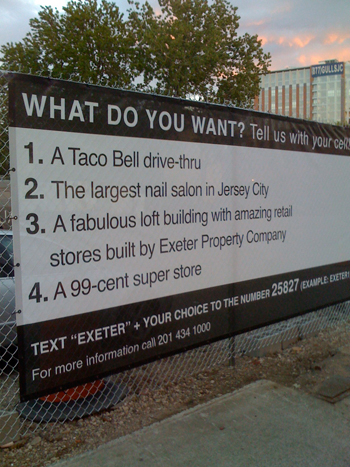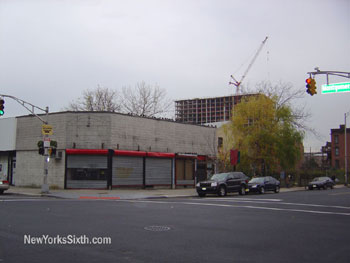While residents of the Powerhouse District are lawyering up to fend off the Toll Brother's development, preservation efforts across the river are getting some added help from the economic downtown. Sort of.
One victim of the recent economy downtown might very well be the ailing Atlantic Yards project in Brooklyn. That redevelopment plan lead by Forest City Ratner called for constructing massive towers in a mixed use development centered around a new basketball arena. Area residents fought the plan in court, delaying construction on the project during the real estate boom. Now the economy is collapsing, credit is drying up, and the project may never be fully realized.
At first glance, a size reduction at the Atlantic Yards project might seem a win for activists. Already Ratner has canceled the would-have-been tallest building in Brooklyn, in favor of a shorter, far less ambitious office tower. On the surface, the economy is helping activists fighting to reduce the size and scope of the project. That is of course, assuming the tower, dubbed B1, is built at all. The Municipal Art Society
put together a slide show of the possible future of the Atlantic Yards, dubbed the Atlantic Lots. One real fear now facing the neighborhood is a shortage of money leading to parking lots instead of development.
As the lawsuits began tipping in Forest City Ratner's favor, the developer seized on the opportunities to begin leveling properties owned by the company, ostensibly in preparation for construction. However, Ratner's early demolition may actually be a scorched earth tactic in the war between new development and preservationists. Thor Equities took a similar approach with their Coney Island properties, leveling large blocks in an effort to leverage the city into approving their plans, threatening to walk away after demolishing acres of land.
In downtown Jersey City, it seems few projects are undertaken without local objection. The most recent controversy includes the Toll Brothers plans for construction of three high rise towers in the Powerhouse Arts District. Another legal battle is currently being fought over the elevated Sixth Street embankment, and of there is course the ever famous 111 First Street fight. As legal battles proceed, many activists may hope the economic slow down makes their fights easier. But as with the Atlantic Yards, activists should be cautious as to what they wish for.
Take for example, the fight over 111 First Street. The hundred year old warehouse was once home to a number of artists. Nearly a decade ago, the buildings owner attempted to evict the low rent tenants and built a new tower on top of the old warehouse. A protracted legal battle followed, with the city eventually capitulating to the developer. With great fanfare, plans for a showcase tower by starchitect Rem Koolhaus was announced, the old warehouse demolished, and then the bottom fell out of the credit market.
The lot at 111 First Street current plays host to a pile of dirt, construction detritus from the lot across the street. A metal cyclone fence surrounds the empty lot, littered with bricks and other debris. Rumors are rampant that the site, idle for months, may not be getting a Rem Koolhaus tower anytime soon. And the final design, when a building is eventually constructed on the site, may be trimmed from the formerly ambitious designs announced to the world, all to accommodate new budgets and fiscal realities. Until then of course, the city has another empty lot. At least for now no one has applied to zone the site as an interim parking lot, a fate all too common in the downtown.
In the late 1990s, the Millennium Towers project, two 43 story towers proposed for the Hoboken border raised the ire of Jersey City heights residents afraid of losing their precious views of the Manhattan skyline. Now, ten years later, proposals for high rise construction above the Hoboken rail yards will likely obstruct Height's residents views, and the lots in Jersey City where the Millennium Towers would have been built are still vacant, former industrial sites.
Residents of the Powerhouse District threatened a lawsuit even before the city council approved zoning changes allowing the Toll Brothers to build high rise towers. All the residents are doing is assuring a lengthy legal battle before a single brick is laid. Already the district is scarred. The heart of the Powerhouse district has been an abandoned construction site since last March. Developers of the Provost Square development broke ground, drilled a few pilings, and then walked away after reaching an agreement with the Toll Brothers. The Manischewitz factory has been closed for more than a year (and caused a Matzah shortage too).
Abandoned construction sites and empty factories can hardly be what neighborhood residents had in mind when they demanded lower density. But with all signs pointing to weakening economy, even if residents win their legal battles, they may still end up the losers. A court ruling in the residents favor may not improve the neighborhood at all. Reducing allowable density with a slow economy and tight credit market might make it impossible for any developer to acquire financing for a smaller scale project for years to come. That would leave the neighborhood with empty warehouses and abandoned construction. On the other hand, residents could lose the legal fight anyway, but delay Toll's ground breaking long enough to make construction impossible for years to come, again leading to a long period with empty warehouses and abandoned construction.
In all likelihood, local government in Jersey City will do its best to help see projects along. Most recently, the city council revisited revised tax abatements for the Monaco Towers after it seemed as though the project had all but fallen apart. But even a city with a pro-development agenda is impotent against a waning economy. Ultimately, fighting development can be a high stakes poker game, and even the winner may feel cheated in the end.




